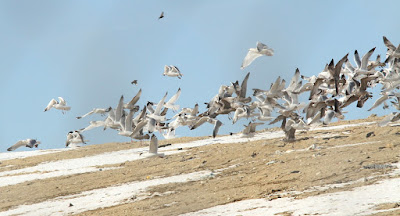Tim and I swung through the south county earlier. We spent some time at the Forest Lawn landfill and were just about to leave when he picked an adult California Gull off the front face. The bird stayed just long enough for me to get a look through his scope before the entire flock took off.
I blasted blindly at them not knowing if the bird would come back. Can you pick out the California?
It turns out it's there more or less centered, the upper left corner of the inset points to it.
After a few anxious minutes not expecting to have documented the bird it returned and settled back down on the southern face of the dump
Midday lighting with the bird shot through a chain link fence with the inevitable wind distortion didn't make for great shooting, but the long straight bill with black and red sub-terminal tip, leg color and darker mantle color is there.
Fortunately the birds took off again, though this time more slowly. Nevertheless, if you think it's easy to follow one essentially identical gull out of at least 500 others through a chain-link fence and a view-finder with birds milling in both directions and clouds of starlings periodically chaffing the target, well feel free to try it.
California Gull has a bit more black in the primaries than does the average HERG or RBGU and a little heavier head streaking which streamed out from behind the eye. A look at the upperside:
If you decide you want to try your luck, make sure you sign in at the landfill office. This was the 3rd California Gull I've seen in Berrien; the county accounts for more Cal Gulls than the rest of the state combined.





























